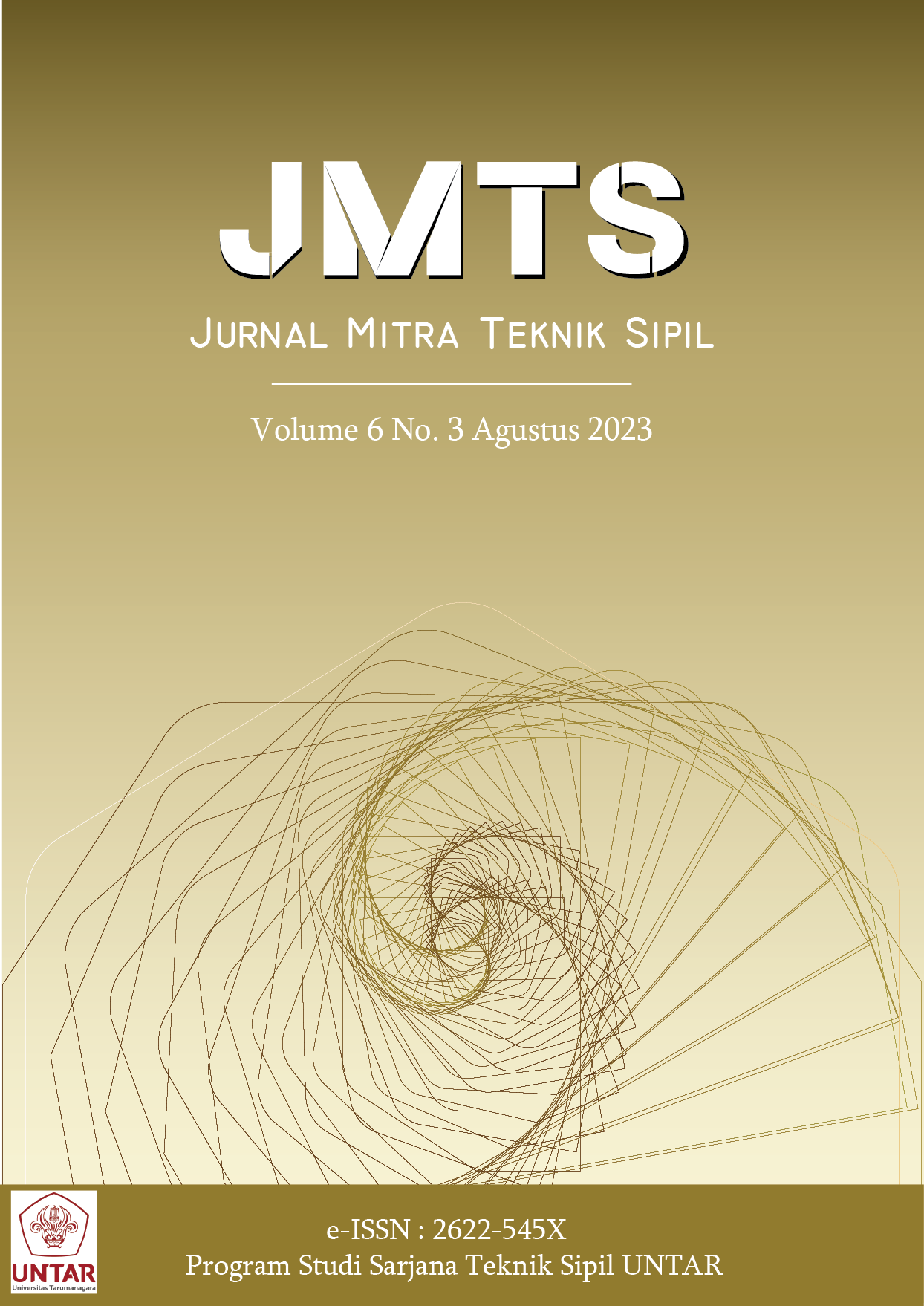ANALISIS KAPASITAS PELAT BETON RINGAN MENGGUNAKAN APLIKASI MIDAS FEA
Main Article Content
Abstract
The use of concrete in a building has been well-known since the 1800s. Many concrete models are new to the present and still growing, one of which is lightweight concrete. Lightweight concrete is the manufacture of ordinary concrete with the addition of styrofoam. The addition of styrofoam is useful as a cavity shaper, so the volume of concrete will increase without the addition of paste or other aggregates. The density of lightweight concrete that has been made is in the range of 1850 kg/m3-1900 kg/m3. After the Laboratorium was tested, we got a density of around 1373.5 kg/m3. The process of calculating the structure is also very developed to date. Many calculation methods used by experts in building design include the use of the Finite element method. This Finite element method is used for obtaining results that detail the behaviour of structures such as tensile strength, compressive strength, deformation, stress and others. In the study will be made an experiment to make a Laboratorium with lightweight concrete with wire mesh reinforcement with a diameter of 4 mm. after the testing process with manual test with Laboratorium tests and with the help of the Midas Finite Element Analyst application. The results of this test turned out to be the same when the load reached 800 kg of test objects in Midas FEA and Laboratorium tests were both destroyed, but the deformation results were quite far apart, this is happened because Midas could not detect certain materials with certain parameters in its application.
Abstrak
Penggunaan beton pada suatu bangunan sudah terkenal sejak 1800an dan terus berkembang sampai sekarang. Banyak model-model beton yang baru untuk sekarang ini dan terus bertambah sampai sekarang salah satunya adalah beton . Beton ringan merupakan pembuatan beton biasa dengan tambahan styrofoam. Penambahan styrofoam ini berguna sebagai pembentuk rongga, sehingga volume beton akan bertambah tanpa tambahan pasta atau agregat lain. Massa jenis beton ringan yang telah dibuat oleh para ilmuwan adalah berkisar 1850 kg/m3-1900 kg/m3. Setelah proses pengujian selesai hasil yang kami dapatkan 1373.5 kg/m3. Proses Perhitungan struktur juga sangat berkembang sampai saat ini. Bayak metode perhitungan yang dipakai para ahli dalam perancangan bangunan salah satunya penggunaan metode finite element. Metode finite element ini berguna untuk mendapatkan hasil yang perilaku detail struktur seperti kuat tarik, kuat tekan, deformasi, tegangan dan lainnya. Pada penelitian akan dibuat percobaan membuat pelat dengan beton ringan dengan tulangan wiremesh dengan diameter 4 mm. setelah itu proses pengujian akan dibuat secara manual yaitu uji Laboratorium dan dengan bantuan aplikasi Midas Finite Element Analyst. Hasil dari pengujian ini ternyata sama pada saat beban mencapai 800 kg benda uji dalam Midas FEA dan uji Laboratorium sama-sama hancur, tetapi hasil deformasi yang berbeda cukup jauh, ini dikarenakan Midas tidak dapat mendeteksi bahan tertentu dengan parameter tertentu dalam aplikasinya.
Article Details

This work is licensed under a Creative Commons Attribution-NonCommercial-ShareAlike 4.0 International License.
This work is licensed under Jurnal Mitra Teknik Sipil (JMTS) Creative Commons Attribution-ShareAlike 4.0 International License.References
Hadipramana, J., & Jaka, S. (2020). Perbandingan Simulasi Gaya Aksial Dan Lateral Plain, Progress In Civil Engineering Journal, 8-19.
Karimi, A. K., Aasim, B. A., & Tomiyama, J. (2021). A Numerical Study On The Control Of Horizontal Cracking At The Ends Of BS22 Hollow-Type PC-Girders Utilizing Midas. Journal Of Physics: Conference Series.
Mulyono, T. (2004). Teknik Beton. Jakarta: Andi Offset.
Nawy, E. G. (1998). Beton Bertulang (Suatu Pendekatan Dasar). Bandung: PT. Rafika Aditama.
Priyono, Y. J., & Nadia. (2014). Pengaruh Penggunaan Styrofoam Sebagai Pengganti Agregat Kasar, Jurnal Konstruksia, 55-61.
Purnawirati, I. N. (2020). Pengaruh Faktor Air Semen Terhadap Sifat Mekanik Beton Ringan Styrofoam, Jurnal Kacapuri, 59-70.
Setyowati, M. (2019). Berkala Arkeologi. Perkembangan Penggunaan Beton Bertulang Di Indonesia Pada Masa Kolonial (1901-1942), 201-220.
Siahaan, N. S., Sumajouw, M. D., & Mondoringin, M. R. (2020). Penggunaan Styrofoam Sebagai Substitusi Parsial Agregat Kasar Terhadap Nilai Kuat Tekan Dan Kuat Tarik Belah Bon Ringan, Jurnal Sipil Statik Vol.8 No.4., 635-644.
Hadi, S. (2019). Analisis Kuat Tekan Beton Ringan Dengan Bahan Tambah Styrofoam, Binawakya, 2533-2540.



